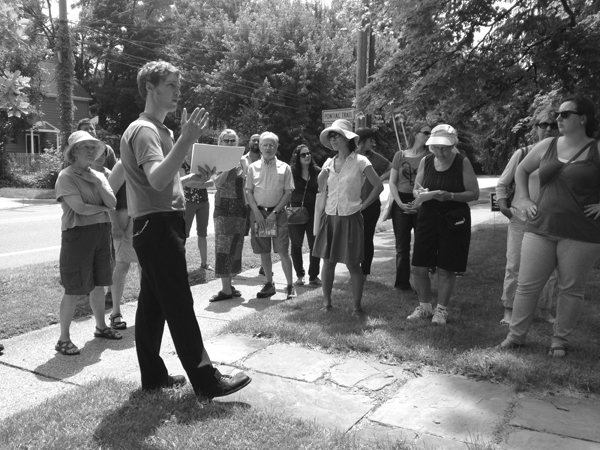
by P.D. Lesko
THE HISTORIC LOWER Town district is home to several of Ann Arbor’s oldest standing residences and buildings. The last standing home built by a city founder, Anson Brown, is located at 1029 Pontiac Trail and built around 1830. Businessman Brown owned several buildings, as well. The oldest of them is in Lower Town and houses St. Vincent DePaul’s. Built in the 1830s, it is the oldest commercial building still standing in the city.
Barbara Lucas helped organize the very first River Hop three years ago, and was thrilled at this year’s turnout, the weather and the fact that she delegated much of the work this time around—her daughter’s wedding demanded much of her attention.
“It’s a wonderful event,” said Lucas, during the well-attended neighborhood potluck dinner held at Beckley Park.
The park is named for the Reverend Guy Beckley, an abolitionist whose home located at 1425 Pontiac Trail was a stop on the Underground Railroad.
It was Rev. Beckley who published the abolitionist newspaper, The Signal of Liberty.

Historic Highlight Walk tour leader Patrick McCauley is the co-author of Historic Ann Arbor: An Architectural Guide. For two hours on Sunday afternoon, McCauley and a group of about 15 residents of Lower Town walked up and down the streets of Lower Town learning about the history of the homes.
The focus of the tour was on Lower Town’s rep as a hotbed of abolitionist sentiment.
“There was a mainstream newspaper in Ann Arbor at the time which referred to abolitionists as “no better than horse thieves,” said McCauley, “who deserved to be shot.”
The Perry House, located at 1317 Pontiac Trail was built in 1836. It has one of the oldest barns on the city and a hidden box between back-to-back fireplaces which is large enough to hold two people. There is speculation that it was a space for hiding runaway slaves, but no record exists that the Perry House was a stop on the Underground Railroad.
The River Hop culminated with a potluck at Beckley Park. There, three groups took turns performing zydeco, country and pop music for three hours.
Neighbors swapped recipes, chatted and swayed to the music while kids ran through the cool grass and rolled down the hill on the north side of the park.
Beckley Park abuts Fairview Cemetary which opened in 1831. One can’t help but imagine that perhaps the spirits of Anson Brown, Rev. Guy Beckley and Absolom Traver, all buried at Fairview, rise on moonlit nights. Surely the spirits of Beckley, Brown and Traver walk the streets of Lower Town, past the homes they built and under the trees they planted, happy that so many of the secrets they kept can now be freely shared.


